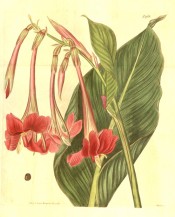Canna iridiflora Ruiz & Pav.
Half-hardy, upright, rhizomatous perennial with long, dark bluish-green leaves and pendant panicles of trumpet-shaped bright cerise-pink flowers with reflexed petals, in summer and autumn. To 3m. [RHSE, Hortus].
Horticultural & Botanical History
‘It flowered in the month of May, and is unrivalled in beauty in the genus. The stem was about six feet in height.’ [LBC no.905/1825]. ‘This is undoubtedly by far the most splendid species of Canna that is yet known. […] Native of Peru, or at least is cultivated in the gardens of the Peruvian town Pillao, where it flowers from May to October. […] It was raised from seeds under rather peculiar circumstances; for having received in the year 1816, from the celebrated Don Jos. Pavon, several hundred sorts of seeds and fruits collected in his travels through Peru and Chili, Mr. [Aylmer Bourke] Lambert determined, notwithstanding the great length of time they had been collected, to try and raise such as he thought most likely to retain their vegetating property. Out of these he was fortunate in raising eighteen species, which are now growing in his hot-house at Boynton; amongst these are the Canna iridiflora.’ [BM t.1968/1815]. Introduced to Britain in 1816. [JD]. FS f.1360/1858.
History at Camden Park
Listed in all published catalogues [B.61/1843].
Notes
Canna iridiflora Willd. (1822) = Canna gigantea F.Delaroche, usually considered a form of Canna indica L.
Published Jan 18, 2009 - 03:30 PM | Last updated Jul 16, 2010 - 01:37 PM
| Family | Cannaceae |
|---|---|
| Category | |
| Region of origin | Peru |
| Synonyms | |
| Common Name | |
| Name in the Camden Park Record | Canna Iridiflora |
| Confidence level | high |


